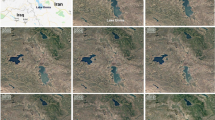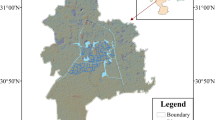Abstract
A two-dimensional hydrodynamic and water quality numerical flow model has been developed for Lake Mariout to simulate the flow pattern in the lake vicinity of the study area, the discharges and pollution loadings coming from the agricultural drains, and the point sources discharged directly to the lake. After the model development and calibration, different potential model scenarios were suggested for increasing the storage capacity of the lake’s basins and its impact on lake hydraulics, and therefore water quality conditions have been implemented.
The first scenario was to study the deepening one or more basin and the effect of this deepening on water levels on different basins and the effect on the performance of El Mex pumping station and whether the pump station can lift the new lifting head or not. If there is an effect on the water surface of the lake, the model studied the optimum operation scenario for operating the El Mex pumping station. Also, different scenarios for high flood events have been studied and how shall flood water be stored in the basins and be lifted to the sea. Also, a study was carried on the possibility of using the Wadi Mariout as an emergency storage basin by connecting it to the current lake’s basins and its capacity to accumulate future floods. Finally, a scenario has been conducted on the diversion of inflowing drains for agriculture reuse and the inflow into the lake with evaporation compensation. The results indicated that 1 m dredging works in the northern, western, and southern basin would improve the circulation in the lake. Moreover, it will increase the storage capacity and will improve the water quality. Also, a connection between the southwestern basins with the salt basin will improve the water circulation and storage capacity of the lake.
Access this chapter
Tax calculation will be finalised at checkout
Purchases are for personal use only
Similar content being viewed by others
References
ALAMIM (2009) Integrated action plan, EC-SMAP III (Alexandria Lake Mariout Integrated Management). American Public Health, Washington
Donia N (2016) Water quality modelling of Northern lakes case study (Egyptian Northern lakes). In: Rashed MN (ed) Lake sciences and climate change. ISBN 978-953-51-2557-0, Print ISBN 978-953-51-2556-3
Hamilton DP, Schladow SG (1997) Prediction of water quality in lakes and reservoirs. Part I – model description. Ecol Model 96(1–3):91–110
Haralampides K, Georgiou IY, McCorquodale AJ (2000) Water quality impacts on the Lake Pontchartrain Estuarine System. Proc Water Environ Fed 10:402–425
Jin KR, Hamrick JH, Tisdale T (2000) Application of three-dimensional hydrodynamic model for Lake Okeechobee. J Hydraul Eng 126(10):758–771
Chung EG, Bombardelli FA, Schladow SG (2009) Sediment resuspension in a shallow lake. Water Resour Res 45:W05422. https://doi.org/10.1029/2007WR006585
Jin KR, Ji ZG, James RT (2007) Three-dimensional water quality and SAV modeling of a large shallow lake. J Great Lakes Res 33(1):28–45
Schladow SG, Hamilton DP (1997) Prediction of water quality in lakes and reservoirs: part II – model calibration, sensitivity analysis and application. Ecol Model 96(1–3):111–123
Delft3D-FLOW (2015) Simulation of multi-dimensional hydrodynamic and transport phenomena, including sediments. Deltares, Delft
Delft3D-Water Quality (2015) Water quality and aquatic ecology modelling suite. Deltares, Delft
Acknowledgments
Special thanks to the Alexandria Coastal Zone Management Project 2015–2017 financed by the Global Environment Facility (GEF) managed through the World Bank in coordination with the Egyptian Environmental Affairs Agency (EEAA) for providing the data required to accomplish this work.
Author information
Authors and Affiliations
Corresponding author
Editor information
Editors and Affiliations
Rights and permissions
Copyright information
© 2018 Springer International Publishing AG, part of Springer Nature
About this chapter
Cite this chapter
Donia, N. (2018). Investigating the Impacts of Dredging on Improving the Water Quality and Circulation of Lake Mariout via Hydrodynamics. In: Negm, A., Bek, M., Abdel-Fattah, S. (eds) Egyptian Coastal Lakes and Wetlands: Part II. The Handbook of Environmental Chemistry, vol 72. Springer, Cham. https://doi.org/10.1007/698_2018_323
Download citation
DOI: https://doi.org/10.1007/698_2018_323
Published:
Publisher Name: Springer, Cham
Print ISBN: 978-3-319-93610-9
Online ISBN: 978-3-319-93611-6
eBook Packages: Earth and Environmental ScienceEarth and Environmental Science (R0)




